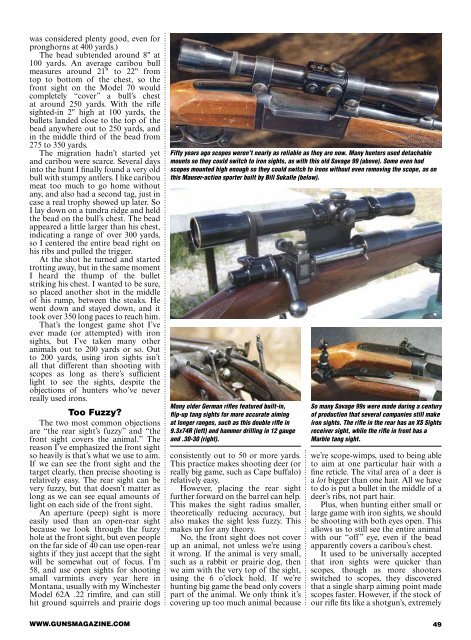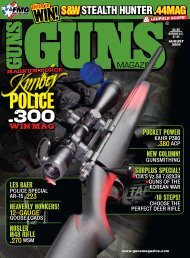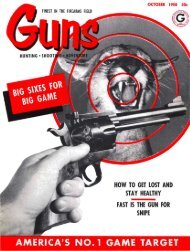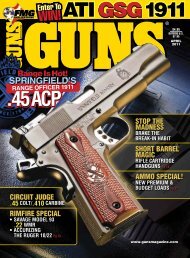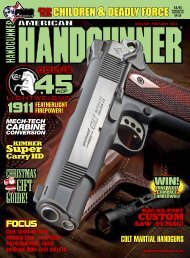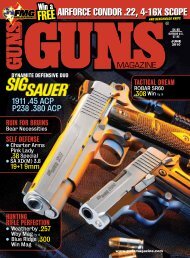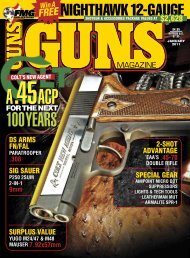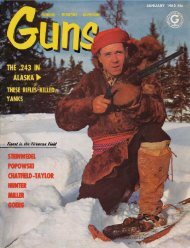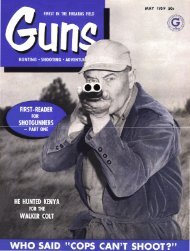Guns 2011-02.pdf - Jeffersonian
Guns 2011-02.pdf - Jeffersonian
Guns 2011-02.pdf - Jeffersonian
Create successful ePaper yourself
Turn your PDF publications into a flip-book with our unique Google optimized e-Paper software.
was considered plenty good, even for<br />
pronghorns at 400 yards.)<br />
The bead subtended around 8" at<br />
100 yards. An average caribou bull<br />
measures around 21" to 22" from<br />
top to bottom of the chest, so the<br />
front sight on the Model 70 would<br />
completely “cover” a bull’s chest<br />
at around 250 yards. With the rifle<br />
sighted-in 2" high at 100 yards, the<br />
bullets landed close to the top of the<br />
bead anywhere out to 250 yards, and<br />
in the middle third of the bead from<br />
275 to 350 yards.<br />
The migration hadn’t started yet<br />
and caribou were scarce. Several days<br />
into the hunt I finally found a very old<br />
bull with stumpy antlers. I like caribou<br />
meat too much to go home without<br />
any, and also had a second tag, just in<br />
case a real trophy showed up later. So<br />
I lay down on a tundra ridge and held<br />
the bead on the bull’s chest. The bead<br />
appeared a little larger than his chest,<br />
indicating a range of over 300 yards,<br />
so I centered the entire bead right on<br />
his ribs and pulled the trigger.<br />
At the shot he turned and started<br />
trotting away, but in the same moment<br />
I heard the thump of the bullet<br />
striking his chest. I wanted to be sure,<br />
so placed another shot in the middle<br />
of his rump, between the steaks. He<br />
went down and stayed down, and it<br />
took over 350 long paces to reach him.<br />
That’s the longest game shot I’ve<br />
ever made (or attempted) with iron<br />
sights, but I’ve taken many other<br />
animals out to 200 yards or so. Out<br />
to 200 yards, using iron sights isn’t<br />
all that different than shooting with<br />
scopes as long as there’s sufficient<br />
light to see the sights, despite the<br />
objections of hunters who’ve never<br />
really used irons.<br />
Too Fuzzy?<br />
The two most common objections<br />
are “the rear sight’s fuzzy” and “the<br />
front sight covers the animal.” The<br />
reason I’ve emphasized the front sight<br />
so heavily is that’s what we use to aim.<br />
If we can see the front sight and the<br />
target clearly, then precise shooting is<br />
relatively easy. The rear sight can be<br />
very fuzzy, but that doesn’t matter as<br />
long as we can see equal amounts of<br />
light on each side of the front sight.<br />
An aperture (peep) sight is more<br />
easily used than an open-rear sight<br />
because we look through the fuzzy<br />
hole at the front sight, but even people<br />
on the far side of 40 can use open-rear<br />
sights if they just accept that the sight<br />
will be somewhat out of focus. I’m<br />
58, and use open sights for shooting<br />
small varmints every year here in<br />
Montana, usually with my Winchester<br />
Model 62A .22 rimfire, and can still<br />
hit ground squirrels and prairie dogs<br />
Fifty years ago scopes weren’t nearly as reliable as they are now. Many hunters used detachable<br />
mounts so they could switch to iron sights, as with this old Savage 99 (above). Some even had<br />
scopes mounted high enough so they could switch to irons without even removing the scope, as on<br />
this Mauser-action sporter built by Bill Sukalle (below).<br />
Many older German rifles featured built-in,<br />
flip-up tang sights for more accurate aiming<br />
at longer ranges, such as this double rifle in<br />
9.3x74R (left) and hammer drilling in 12 gauge<br />
and .30-30 (right).<br />
consistently out to 50 or more yards.<br />
This practice makes shooting deer (or<br />
really big game, such as Cape buffalo)<br />
relatively easy.<br />
However, placing the rear sight<br />
further forward on the barrel can help.<br />
This makes the sight radius smaller,<br />
theoretically reducing accuracy, but<br />
also makes the sight less fuzzy. This<br />
makes up for any theory.<br />
No, the front sight does not cover<br />
up an animal, not unless we’re using<br />
it wrong. If the animal is very small,<br />
such as a rabbit or prairie dog, then<br />
we aim with the very top of the sight,<br />
using the 6 o’clock hold. If we’re<br />
hunting big game the bead only covers<br />
part of the animal. We only think it’s<br />
covering up too much animal because<br />
So many Savage 99s were made during a century<br />
of production that several companies still make<br />
iron sights. The rifle in the rear has an XS Sights<br />
receiver sight, while the rifle in front has a<br />
Marble tang sight.<br />
we’re scope-wimps, used to being able<br />
to aim at one particular hair with a<br />
fine reticle. The vital area of a deer is<br />
a lot bigger than one hair. All we have<br />
to do is put a bullet in the middle of a<br />
deer’s ribs, not part hair.<br />
Plus, when hunting either small or<br />
large game with iron sights, we should<br />
be shooting with both eyes open. This<br />
allows us to still see the entire animal<br />
with our “off” eye, even if the bead<br />
apparently covers a caribou’s chest.<br />
It used to be universally accepted<br />
that iron sights were quicker than<br />
scopes, though as more shooters<br />
switched to scopes, they discovered<br />
that a single sharp aiming point made<br />
scopes faster. However, if the stock of<br />
our rifle fits like a shotgun’s, extremely<br />
WWW.GUNSMAGAZINE.COM 49


